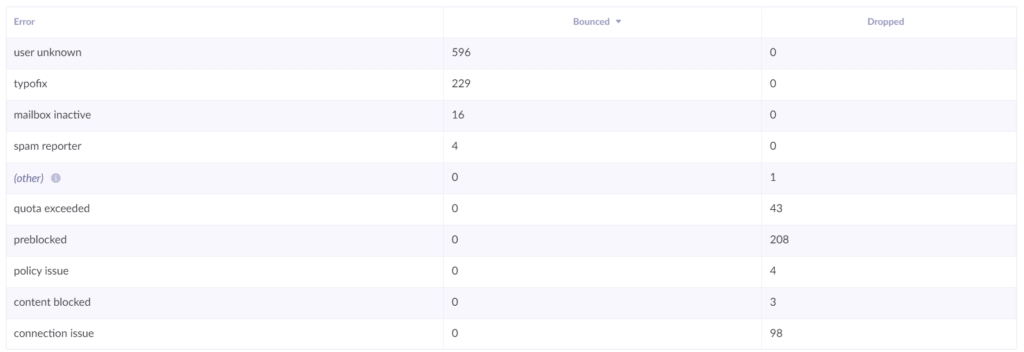Email performance reports
Performance dashboards are now availableOnce you define your campaign goals and KPIs, you are ready to create the reports. A few major reports will tell you most of what you need to know about your emailing, including deliverability performance and campaign performance. We will go over these reports, explaining what they tell you and how they add value.
Performance dashboards are now available
Try our new Performance dashboards for improved analytics and multi-channel insights.
Email domain report
The first one is the email domain report, which shows you metrics for specific recipient domains. This will help you see any deliverability issues with a particular mailbox provider – and you can use the open rate variance metric here. If a certain provider shows a 30% lower open rate than the other, this is most likely due to bad inbox placement. Similarly, if there is any spike for soft bounces or hard bounces, you should look into what is causing those issues.

We have created a detailed guide on how to create this report in Bloomreach Engagement. Read more about Email Domain Report.
Campaign report
The second perspective, which uses mostly the same set of metrics in a different format, is the campaign report. You can get this report by using the previous Email domain report, but in rows, you should use “campaign > campaign_name” instead of “email_domain”. You can also add “campaign > subject” as an extra row in case you want to see the subject lines used or if you tested various subject lines.
This allows you to monitor how your campaigns are doing, for example, how different content influences the click rate, how a different subject line affects the open rate.

Soft bounce and bounce report
If you spot any problems in the campaign/email domain report, you can use the following report to investigate further. This will help you understand where soft or hard bounces are coming from: is it bad email list health, or is your content being blocked?

Here’s a short video on how you can set up such a report in Bloomreach Engagement:
Once you find out the most common issues, you can start solving them. In this regard, you might find our Email Deliverability Tips useful.
Open and click time report
You can build the following report to help you understand when customers are opening or clicking on your emails and whether this is in line with their usual shopping time. You will see most of the opens and clicks happen after sending the campaign, but you might find out that this isn’t when your customers typically do their shopping. You can then use optimal send time prediction to manage this for you or manually adjust the campaign launch times.
Let’s take a look at the report in the following image. At first sight, we can see a high open-to-purchase ratio before lunch when the email is sent. But then we can see that customers are opening fewer emails but still shopping.

If we hide opens from this view and look at clicks only, we can see spikes in clicks in the morning and late evening, but they don’t correlate with when purchases are happening.

Here, you could benefit from using optimal send time prediction, as this ensures that every customer receives an email at their optimal time. If this prediction isn’t available to you, you can also use this to segment morning and evening shoppers and send campaigns at two different times for these two segments.
Here’s a short video on how you can set up such a report in Bloomreach Engagement:
Updated 6 months ago
